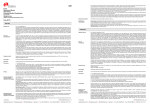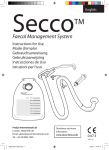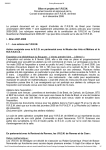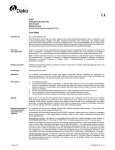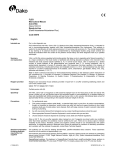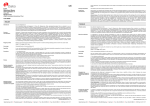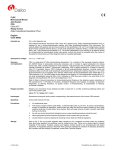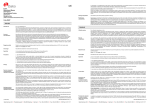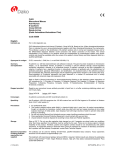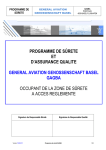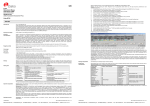Download FLEX Monoclonal Mouse Anti-Human CDX2 Clone DAK
Transcript
FLEX Monoclonal Mouse Anti-Human CDX2 Clone DAK-CDX2 Ready-to-Use (Dako Autostainer/Autostainer Plus) Code IS080 English Intended use For in vitro diagnostic use. FLEX Monoclonal Mouse Anti-Human CDX2, Clone DAK-CDX2, Ready-to-Use (Dako Autostainer/Autostainer Plus), is intended for use in immunohistochemistry together with Dako Autostainer/Autostainer Plus instruments. Antibodies to CDX2 may be useful for the identification of cells from adenocarcinomas and carcinoids of the gastrointestinal tract. The clinical interpretation of any staining or its absence should be complemented by morphological studies using proper controls and should be evaluated within the context of the patient's clinical history and other diagnostic tests by a qualified pathologist. Synonym for antigen Caudal-type homeobox protein 2 (1). Summary and explanation Cdx2 is the human homologue of a Drosophila caudal-type homeobox gene that encodes a transcription factor expressed in intestinal epithelial cells of adult mammals. CDX2 transcription factor regulates both cell proliferation and differentiation of intestinal epithelial cells (1-3). Members of the Cdx gene family are thought to play an important role in establishing and maintaining the intestinal phenotype during development through transcriptional activation of differentiated intestinal genes (2, 3). The CDX2 protein is expressed in the nuclei of intestinal epithelial cells from the duodenum to the rectum (4). CDX2 expression has been observed in normal adult intestinal epithelial cells such as absorptive, goblet, endocrine and Paneth cells. Scattered expression has been reported in pancreatic ductules, but no expression was observed in other normal tissues/cells tested including adipocytes, adrenal cortex and medulla, bile duct epithelium, breast epithelium, gall bladder, gastric mucosa (excluding glands with intestinal metaplasia), kidney cortex and medulla, liver, lung alveoli, lymph node, mesothelium, ovary, skin (squamous epithelia and sweat glands), testis, or thyroid gland (4, 5). CDX2 expression has been reported in 86-100% of colorectal adenocarcinomas, including primary and metastatic tumors (4-8). Expression of CDX2 has also been reported in 22-70% of gastric adenocarcinomas and in carcinoids of the GI tract, with a high degree of positivity observed in carcinoids of the midgut region (5-9). CDX2 expression has been observed in mucinous ovarian adenocarcinoma (11-100%) and adenocarcinomas of the urinary bladder (47-100%), pancreas (32-60%) and prostate (2-6%) (4-8, 10, 11). Refer to Dako’s General Instructions for Immunohistochemical Staining or the detection system instructions of IHC procedures for: 1) Principle of Procedure, 2) Materials Required, Not Supplied, 3) Storage, 4) Specimen Preparation, 5) Staining Procedure, 6) Quality Control, 7) Troubleshooting, 8) Interpretation of Staining, 9) General Limitations. Reagent provided Ready-to-use monoclonal mouse antibody provided in liquid form in a buffer containing stabilizing protein and 0.015 mol/L sodium azide. Clone: DAK-CDX2. Isotype: IgG1, kappa. Immunogen Recombinant human CDX2 corresponding to amino acids 1-165. Specificity In Western blotting of Caco-2 lysate the antibody labels a 37 kDa and 40 kDa band corresponding to the expected molecular weight of CDX2 (2). Additional bands at 17 kDa and 19 kDa were also labeled by the antibody. Precautions 1. 2. 3. 4. 5. Storage (119006-001) For professional users. This product contains sodium azide (NaN3), a chemical highly toxic in pure form. At product concentrations, though not classified as hazardous, sodium azide may react with lead and copper plumbing to form highly explosive build-ups of metal azides. Upon disposal, flush with large volumes of water to prevent metal azide build-up in plumbing. As with any product derived from biological sources, proper handling procedures should be used. Wear appropriate Personal Protective Equipment to avoid contact with eyes and skin. Unused solution should be disposed of according to local, State and Federal regulations. Store at 2-8 °C. Do not use after expiration date s tamped on vial. If reagents are stored under any conditions other than those specified, the conditions must be verified by the user. There are no obvious signs to indicate instability of this product. Therefore, positive and negative controls should be run simultaneously with patient specimens. If unexpected staining is observed which cannot be explained by variations in laboratory procedures and a problem with the antibody is suspected, contact Dako Technical Support. 307725EFG_001 p. 1/8 Specimen preparation including materials required but not supplied The antibody can be used for labeling formalin-fixed, paraffin-embedded tissue sections. Tissue specimens should be cut into sections of approximately 4 µm. Pre-treatment with heat-induced epitope retrieval (HIER) is required. Optimal results are obtained by pretreating tissues using EnVision FLEX Target Retrieval Solution, High pH (10x), (Dako Autostainer/Autostainer Plus) (Code K8010/K8014). Deparaffinized sections: Pre-treatment of deparaffinized formalin-fixed, paraffin-embedded tissue sections is recommended using Dako PT Link (Code PT100/PT101). For details, please refer to the PT Link User Guide. Follow the pre-treatment procedure outlined in the package insert for EnVision FLEX Target Retrieval Solution, High pH (10x), (Dako Autostainer/Autostainer Plus) (Code K8010/K8014). The following parameters should be used for PT Link: Pre-heat temperature: 65 °C; epit ope retrieval temperature and time: 97 °C for 20 (± 1) minutes; cool down to 65 °C. Remove Autostainer slide rack w ith slides from the PT Link tank and immediately dip slides into a jar/tank (e.g., PT Link Rinse Station, Code PT109) containing diluted room temperature EnVision FLEX Wash Buffer (10x), (Dako Autostainer/Autostainer Plus) (Code K8010). Leave slides in Wash Buffer for 1-5 minutes. Paraffin-embedded sections: As alternative specimen preparation, both deparaffinization and epitope retrieval can be performed in the PT Link using a modified procedure. See the PT Link User Guide for instructions. After the staining procedure has been completed, the sections must be dehydrated, cleared and mounted using permanent mounting medium. The tissue sections should not dry out during the treatment or during the following immunohistochemical staining procedure. For greater adherence of tissue sections to glass slides, the use of Dako Silanized Slides (Code S3003) is recommended. Staining procedure including materials required but not supplied The recommended visualization system is EnVision FLEX, High pH, (Dako Autostainer/Autostainer Plus) (Code K8010). The staining steps and incubation times are pre-programmed into the software of Dako Autostainer/Autostainer Plus instruments, using the following protocols: Template protocol: FLEXRTU2 (200 µL dispense volume) or FLEXRTU3 (300 µL dispense volume) Autoprogram: CDX2 (without counterstaining) or CDX2H (with counterstaining) The Auxiliary step should be set to “rinse buffer” in staining runs with ≤10 slides. For staining runs with >10 slides the Auxiliary step should be set to “none”. This ascertains comparable wash times. All incubation steps should be performed at room temperature. For details, please refer to the Operator’s Manual for the dedicated instrument. If the protocols are not available on the used Dako Autostainer instrument, please contact Dako Technical Services. Optimal conditions may vary depending on specimen and preparation methods, and should be determined by each individual laboratory. If the evaluating pathologist should desire a different staining intensity, a Dako Application Specialist/Technical Service Specialist can be contacted for information on re-programming of the protocol. Verify that the performance of the adjusted protocol is still valid by evaluating that the staining pattern is identical to the staining pattern described in “Performance characteristics”. Counterstaining in hematoxylin is recommended using EnVision FLEX Hematoxylin, (Dako Autostainer/Autostainer Plus) (Code K8018). Non-aqueous, permanent mounting medium is recommended. Positive and negative controls should be run simultaneously using the same protocol as the patient specimens. The positive control tissue should include appendix and pancreas and the cells/structures should display reaction patterns as described for this tissue in “Performance characteristics” in all positive specimens. The recommended negative control reagent is FLEX Negative Control, Mouse, (Dako Autostainer/Autostainer Plus) (Code IS750). Staining interpretation The cellular staining pattern is nuclear. Performance characteristics Normal tissues: Tissue Type (# tested) (119006-001) Positively Staining Tissue Elements Adrenal (2) 0/2 Appendix (6) 6/6 Nuclear epithelial cells Bone marrow (2) 0/2 Brain/cerebellum (3) 0/3 Brain/cerebrum (3) 0/3 Breast (2) 0/2 Cervix (3) 0/3 Colon (3) 3/3 Glandular epithelium (10-75%) Esophagus (3) 0/3 Kidney (3) 0/3 Lung (3) 0/3 Ovary (3) 0/3 Pancreas (3) 1/3 Ductule epithelium (1%) Pituitary (3) 0/3 307725EFG_001 p. 2/8 Prostate (3) 0/3 Skin (3) 0/3 Stomach (3) 1/3 Gastric epithelium (<1%) Thyroid (3) 0/3 Uterus (3) 0/3 Français Réf. IS080 Utilisation prévue Pour utilisation diagnostique in vitro. L’anticorps FLEX Monoclonal Mouse Anti-Human CDX2, Clone DAK-CDX2, Ready-to-Use (Dako Autostainer/Autostainer Plus), est destiné à être utilisé en immunohistochimie avec les appareils Dako Autostainer/Autostainer Plus. Les anticorps dirigés contre CDX2 peuvent s’avérer utiles pour l’identification de cellules issues d’adénocarcinomes et de carcinoïdes du tractus gastro-intestinal. L’interprétation clinique de toute coloration ou son absence doit être complétée par des études morphologiques en utilisant des contrôles appropriés et doit être évaluée en fonction des antécédents cliniques du patient et d’autres tests diagnostiques par un pathologiste qualifié. Synonyme de l’antigène Protéine à homéoboîte de type caudal 2 (1). Résumé et explication Cdx2 est l’homologue humain d’un gène à homéoboîte de type caudal de la drosophile codant un facteur de transcription exprimé dans les cellules épithéliales intestinales des mammifères adultes. Le facteur de transcription CDX2 régule à la fois la prolifération cellulaire et la différenciation des cellules épithéliales intestinales (1-3). On pense que les membres de la famille de gènes Cdx jouent un rôle important dans l’établissement et le maintien du phénotype intestinal au cours du développement, via l’activation transcriptionnelle de gènes intestinaux différenciés (2, 3). La protéine CDX2 est exprimée dans les noyaux des cellules épithéliales intestinales du duodénum au rectum (4). L’expression de CDX2 a été observée dans les cellules épithéliales intestinales adultes normales telles que les cellules absorbantes, les cellules caliciformes, les cellules endocrines et les cellules de Paneth. Une expression disséminée a été signalée dans les ductules pancréatiques, mais aucune expression n’a été observée dans d’autres tissus/cellules normaux testés, y compris les adipocytes, le cortex et la médulla de la surrénale, l’épithélium des canaux biliaires, la vésicule biliaire, la muqueuse gastrique (à l’exception des glandes présentant une métaplasie intestinale), le cortex et la médulla du rein, le foie, les alvéoles pulmonaires, le ganglion lymphatique, le mésothélium, l’ovaire, la peau (épithélium squameux et glandes sudoripares), le testicule ou la glande thyroïde (4, 5). L’expression de CDX2 a été rapportée dans 86 à 100 % des adénocarcinomes colorectaux, y compris les tumeurs primitives et métastatiques (4-8). L’expression de CDX2 a également été rapportée dans 22 à 70 % des adénocarcinomes gastriques et dans les carcinoïdes du tractus gastro-intestinal, avec un degré de positivité élevé observé dans les carcinoïdes de la région centrale des intestins (5-9). L’expression de CDX2 a été observée dans les adénocarcinomes mucineux de l’ovaire (11-100 %) et les adénocarcinomes de la vessie (47-100 %), du pancréas (32-60 %) et de la prostate (2-6 %) (4-8, 10, 11). Se reporter aux « Instructions générales de coloration immunohistochimique » de Dako ou aux instructions du système de détection relatives aux procédures IHC pour plus d’informations concernant les points suivants : 1) Principe de procédure, 2) Matériels requis mais non fournis, 3) Conservation, 4) Préparation des échantillons, 5) Procédure de coloration, 6) Contrôle qualité, 7) Dépannage, 8) Interprétation de la coloration, 9) Limites générales. Réactifs fournis Anticorps monoclonal de souris prêt à l’emploi fourni sous forme liquide dans un tampon contenant une protéine stabilisante et 0,015 mol/L d’azide de sodium. Clone : DAK-CDX2. Isotype : IgG1, kappa. Immunogène CDX2 humain recombinant correspondant aux acides aminés 1 à 165. Spécificité Par Western Blot de lysats de cellules Caco-2, l’anticorps marque une bande de 37 kDa et une bande de 40 kDa correspondant au poids moléculaire attendu de CDX2 (2). L’anticorps marque également des bandes supplémentaires à 17 kDa et 19 kDa. Précautions 1. 2. 3. 4. 5. (119006-001) Pour utilisateurs professionnels. Ce produit contient de l’azide de sodium (NaN3), un produit chimique hautement toxique sous sa forme pure. Aux concentrations du produit, bien que non classé comme dangereux, l’azide de sodium peut réagir avec le cuivre et le plomb des canalisations et former des accumulations d’azides métalliques hautement explosifs. Lors de l’élimination, rincer abondamment à l’eau pour éviter toute accumulation d’azide métallique dans les canalisations. Comme avec tout produit d’origine biologique, des procédures de manipulation appropriées doivent être respectées. Porter un vêtement de protection approprié pour éviter le contact avec les yeux et la peau. Les solutions non utilisées doivent être éliminées conformément aux réglementations locales et nationales. 307725EFG_001 p. 3/8 Conservation Conserver entre 2 et 8 °C. Ne pas utiliser après la date limite de péremption indiquée sur le flacon. Si les réactifs sont conservés dans des conditions autres que celles indiquées, celles-ci doivent être validées par l’utilisateur. Il n’y a aucun signe évident indiquant l’instabilité de ce produit. Par conséquent, des contrôles positifs et négatifs doivent être testés en même temps que les échantillons de patients. Si une coloration inattendue est observée, qui ne peut être expliquée par un changement des procédures du laboratoire, et en cas de suspicion d’un problème lié à l’anticorps, contacter l’assistance technique de Dako. Préparation des échantillons y compris le matériel requis mais non fourni L’anticorps peut être utilisé pour le marquage des coupes de tissus inclus en paraffine et fixés au formol. L’épaisseur des coupes d’échantillons de tissu doit être d’environ 4 µm. Le prétraitement avec un démasquage d’épitope induit par la chaleur (HIER) est nécessaire. Pour obtenir des résultats optimaux, prétraiter les tissus à l’aide du produit EnVision FLEX Target Retrieval Solution, High pH (10x), (Dako Autostainer/Autostainer Plus) (réf. K8010/K8014). Coupes déparaffinées : Il est recommandé de prétraiter les coupes de tissus fixés au formol et inclus en paraffine qui ont été déparaffinées à l’aide de l’appareil PT Link de Dako (réf. PT100/PT101). Pour plus de détails, se reporter au Guide d’utilisation du PT Link. Suivre la procédure de prétraitement indiquée dans la notice du produit EnVision FLEX Target Retrieval Solution, High pH (10x), (Dako Autostainer/Autostainer Plus) (réf. K8010/K8014). Les paramètres suivants doivent être utilisés pour le PT Link : température de préchauffage : 65 °C ; température et durée du démasquage d’épitope : 97 °C pendant 20 (±1) minute s ; refroidissement jusqu’à 65 °C. Retirer le porto ir à lames Autostainer contenant les lames de la cuve du PT Link et plonger immédiatement les lames dans un récipient/une cuve (par ex., station de rinçage du PT Link, réf. PT109) contenant du tampon de lavage EnVision FLEX Wash Buffer (10x), (Dako Autostainer/Autostainer Plus) (réf. K8010) dilué à température ambiante. Laisser les lames dans le tampon de lavage pendant 1 à 5 minutes. Coupes incluses en paraffine : Comme préparation alternative des échantillons, le déparaffinage et le démasquage d’épitope peuvent être réalisés dans l’appareil PT Link en utilisant une procédure modifiée. Consulter le Guide d’utilisation du PT Link pour obtenir des instructions. Une fois que la procédure de coloration est terminée, les coupes doivent être déshydratées, éclaircies et montées à l’aide d’un milieu de montage permanent. Les coupes de tissus ne doivent pas sécher lors du traitement ni lors de la procédure de coloration immunohistochimique suivante. Pour une meilleure adhérence des coupes de tissus sur les lames de verre, il est recommandé d’utiliser des lames Dako Silanized Slides (réf. S3003). Procédure de coloration y compris le matériel requis mais non fourni Le système de visualisation recommandé est le système EnVision FLEX, High pH, (Dako Autostainer/Autostainer Plus) (réf. K8010). Les étapes de coloration et les temps d’incubation sont préprogrammés dans le logiciel des appareils Dako Autostainer/Autostainer Plus, à l’aide des protocoles suivants : Protocole modèle : FLEXRTU2 (volume de distribution de 200 µL) ou FLEXRTU3 (volume de distribution de 300 µL) Programme automatique : CDX2 (sans contre-coloration) ou CDX2H (avec contre-coloration) L’étape Auxiliary doit être réglée sur « rinse buffer » lors des cycles de coloration avec ≤10 lames. Pour les cycles de coloration de >10 lames, l’étape Auxiliary doit être réglée sur « none ». Cela confirme des temps de lavage comparables. Toutes les étapes d’incubation doivent être effectuées à température ambiante. Pour plus de détails, se reporter au Manuel de l’opérateur spécifique à l'appareil. Si les protocoles ne sont pas disponibles sur l’appareil Dako Autostainer utilisé, contacter l’assistance technique de Dako. Les conditions optimales peuvent varier en fonction du prélèvement et des méthodes de préparation, et doivent être déterminées par chaque laboratoire individuellement. Si le pathologiste qui réalise l’évaluation désire une intensité de coloration différente, un ingénieur d’application/un spécialiste de l’assistance technique de Dako peut être contacté pour obtenir des informations sur la reprogrammation du protocole. Vérifier que les performances du protocole modifié sont toujours valides en vérifiant que le schéma de coloration est identique au schéma de coloration décrit à la section « Caractéristiques de performance ». Il est recommandé d’effectuer une contre-coloration à l’hématoxyline à l’aide du produit EnVision FLEX Hematoxylin, (Dako Autostainer/Autostainer Plus) (réf. K8018). L’utilisation d’un milieu de montage permanent non aqueux est recommandée. Des contrôles positifs et négatifs doivent être testés en même temps et avec le même protocole que les échantillons de patients. Le tissu de contrôle positif doit comprendre l’appendice et le pancréas et les cellules/structures doivent présenter des schémas de réaction semblables à ceux décrits pour ces tissus à la section « Caractéristiques de performance » pour tous les échantillons positifs. Le réactif de contrôle négatif recommandé est le produit FLEX Negative Control, Mouse, (Dako Autostainer/Autostainer Plus) (réf. IS750). Interprétation de la coloration (119006-001) Le schéma de coloration cellulaire est nucléaire. 307725EFG_001 p. 4/8 Caractéristiques de performance Tissus sains : Type de tissus (nbre testés) Éléments tissulaires colorés positivement Surrénale (2) 0/2 Appendice (6) 6/6 : cellules épithéliales, nucléaires Moelle osseuse (2) 0/2 Cerveau, cervelet (3) 0/3 Cerveau, hémisphères cérébraux (3) 0/3 Sein (2) 0/2 Col de l’utérus (3) 0/3 Côlon (3) 3/3 : épithélium glandulaire (10-75 %) Œsophage (3) 0/3 Rein (3) 0/3 Poumon (3) Ovaire (3) 0/3 Pancréas (3) 1/3 : épithélium des ductules (1 %) Hypophyse (3) 0/3 Prostate (3) 0/3 0/3 Peau (3) 0/3 Estomac (3) 1/3 : épithélium gastrique (<1 %) Thyroïde (3) 0/3 Utérus (3) 0/3 Deutsch Code-Nr. IR080 Zweckbestimmung Zur In-Vitro-Diagnostik. FLEX Monoclonal Mouse Anti-Human CDX2, Klon DAK-CDX2, Ready-to-Use (Dako Autostainer/Autostainer Plus) ist zur Verwendung in der Immunhistochemie in Verbindung mit Dako Autostainer/Autostainer Plus-Geräten bestimmt. CDX2-Antikörper dienen zur identifizierung von Zellen aus Adenokarzinomen und Karzinoiden des Magen-Darm-Traktes. Die klinische Auswertung einer eventuell eintretenden Färbung sollte durch morphologische Studien mit geeigneten Kontrollen ergänzt werden und von einem qualifizierten Pathologen unter Berücksichtigung der Krankengeschichte und anderer diagnostischer Tests des Patienten vorgenommen werden. Synonym für das Antigen Caudal-type homeobox protein 2 (1). Zusammenfassung und Erklärung Cdx2 ist ein humanes Homolog eines „caudal-type homeobox gene“ von Drosophila und kodiert einen Transkriptionsfaktor, der in den Darmepithelzellen erwachsener Säugetiere exprimiert wird. Der CDX2Transkriptionsfaktor reguliert sowohl die Proliferation als auch die Differenzierung von intestinalen Epithelzellen (1-3). Es wird angenommen, dass Mitglieder der Cdx-Genfamilie bei der Ausbildung und der Aufrechterhaltung des intestinalen Phänotyps während der Entwicklung eine wesentliche Rolle spielen, indem sie die Transkription von in differenziertem Darmgewebe exprimierten Genen aktivieren (2, 3). Das CDX2-Protein wird in den Zellkernen der intestinalen Epithelzellen vom Zwölffingerdarm bis zum Mastdarm exprimiert (4). CDX2Expression wurde in normalen intestinalen Epithelzellen von Erwachsenen wie z. B. absorbierenden, endokrinen, Becher- und Paneth-Zellen beobachtet. Es wurde eine vereinzelte Expression in den Ausführungsgängen des Pankreas gezeigt, während in anderen getesteten normalen Geweben oder Zellen wie z. B. Fettzellen, Nebennierenrinde und -medulla, Epithelzellen der Gallenwege, Brustepithel, Gallenblase, Magenschleimhaut (ausgenommen Drüsen mit intestinaler Metaplasie), Nierenrinde und -medulla, Leber, Lungenalveolen, Lymphknoten, Mesothel, Ovar, Haut (Plattenepithel und Schweißdrüsen), Hoden und Schilddrüse keine Expression beobachtet wurde (4, 5). CDX2-Expression wurde bei 86-100% von kolorektalen Karzinomen gezeigt, einschließlich primärer und metastatischer Tumore (4–8). CDX2-Expression wurde auch bei 22-70% gastrischer Adenokarzinome und bei Karzinoiden des Magen-Darm-Traktes gezeigt, wobei Karzinoide in der Mitteldarmregion stark positiv waren (5-9). CDX2-Expression wurde bei muzinösen Ovarialadenokarzinomen (11-100%) und Adenokarzinomen der Harnblase (47-100%), des Pankreas (32-60%) und der Prostata (2-6%) (4-8, 10, 11) beobachtet. Folgende Angaben bitte den Allgemeinen Richtlinien zur immunhistochemischen Färbung von Dako bzw. den Anweisungen des Detektionssystems für IHC-Verfahren entnehmen: 1) Verfahrensprinzip, 2) Erforderliche, aber nicht mitgelieferte Materialien, 3) Aufbewahrung, 4) Vorbereitung der Probe, 5) Färbeverfahren, 6) Qualitätskontrolle, 7) Fehlersuche und -behebung, 8) Auswertung der Färbung, 9) Allgemeine Beschränkungen. (119006-001) 307725EFG_001 p. 5/8 Geliefertes Reagenz Gebrauchsfertiger, monoklonaler Maus-Antikörper in flüssiger Form in einem Puffer, der stabilisierendes Protein und 0,015 mol/L Natriumazid enthält. Klon: DAK-CDX2. Isotyp: IgG1, Kappa. Immunogen Rekombinantes humanes CDX2, das den Aminosäuren 1-165 entspricht. Spezifität Beim Western-Blotting von Caco-2-Zelllysaten markierte der Antikörper Banden von 37 kDa und 40 kDa, was mit dem erwarteten Molekulargewicht von CDX2 übereinstimmt (2). Weitere Banden bei 17 kDa und 19 kDa wurden ebenfalls vom Antikörper markiert. Vorsichtsmaßnahmen 1. 2. 3. 4. 5. Für Fachpersonal. Dieses Produkt enthält Natriumazid (NaN3), eine in reiner Form äußerst giftige Chemikalie. Natriumazid kann auch in als ungefährlich eingestuften Konzentrationen mit Blei- und Kupferrohren reagieren und hochexplosive Metallazide bilden. Nach der Entsorgung stets mit viel Wasser nachspülen, um Metallazidansammlungen in den Leitungen vorzubeugen. Wie alle Produkte biologischen Ursprungs müssen auch diese entsprechend gehandhabt werden. Geeignete Schutzkleidung tragen, um Augen- und Hautkontakt zu vermeiden. Nicht verwendete Lösung ist entsprechend örtlichen, bundesstaatlichen und staatlichen Richtlinien zu entsorgen. Lagerung Bei 2–8 °C aufbewahren. Nach Ablauf des auf dem Flä schchen aufgedruckten Verfalldatums nicht mehr verwenden. Werden die Reagenzien nicht entsprechend den angegebenen Bedingungen aufbewahrt, müssen die Bedingungen vom Anwender geprüft werden. Es gibt keine offensichtlichen Anzeichen für eine eventuelle Produktinstabilität. Positiv- und Negativkontrollen sollten daher zur gleichen Zeit wie die Patientenproben getestet werden. Falls es zu einer unerwarteten Färbung kommt, die sich nicht durch Unterschiede bei Laborverfahren erklären lässt und auf ein Problem mit dem Antikörper hindeutet, den technischen Kundendienst von Dako verständigen. Vorbereitung der Probe und erforderliche, aber nicht mitgelieferte Materialien Der Antikörper eignet sich zur Markierung von formalinfixierten und paraffineingebetteten Gewebeschnitten. Gewebeproben sollten in Schnitte von ca. 4 µm Stärke geschnitten werden. Es ist eine Vorbehandlung durch hitzeinduzierte Epitopdemaskierung (HIER-Verfahren) erforderlich. Optimale Ergebnisse können durch Vorbehandlung der Gewebe mit EnVision FLEX Target Retrieval Solution, High pH (10x), (Dako Autostainer/Autostainer Plus) (Code-Nr. K8010/K8014) erzielt werden. Entparaffinierte Schnitte: Die Vorbehandlung entparaffinierter formalinfixierter, paraffineingebetteter Gewebeschnitte sollte mit dem System Dako PT Link (Code-Nr. PT100/PT101) erfolgen. Weitere Informationen hierzu: siehe PT Link-Benutzerhandbuch. Die Vorbehandlung gemäß der Beschreibung in der Packungsbeilage EnVision FLEX Target Retrieval Solution, High pH (10x), (Dako Autostainer/Autostainer Plus) (Code-Nr. K8010/K8014) durchführen. Für das PT LinkSystem sollten die folgenden Parameter verwendet werden: Vorwärmtemperatur: 65 °C; Temperatur und Zeit für Epitopdemaskierung: 97 °C für 20 (±1) Minuten; auf 65 °C abkühlen. Das Autostainer Objektkträgergestel l mit den Objektträgern aus dem PT Link-Behälter herausnehmen und die Objektträger sofort in einen Behälter (z. B. PT Link Rinse Station, Code-Nr. PT109) mit verdünntem, auf Zimmertemperatur gebrachten EnVision FLEX Wash Buffer (10x), (Dako Autostainer/Autostainer Plus) (Code-Nr. K8010) eintauchen. Die Objektträger für 1–5 Minuten im Wash Buffer belassen. Paraffineingebettete Schnitte: Alternativ können Entparaffinierung und Epitopdemaskierung im PT Link unter Verwendung eines modifizierten Verfahrens durchgeführt werden. Weitere Informationen finden Sie im PT LinkBenutzerhandbuch. Nach Abschluss des Färbeverfahrens müssen die Schnitte dehydriert, geklärt und unter Verwendung eines permanenten Fixiermittels fixiert werden. Die Gewebeschnitte dürfen während der Behandlung oder des anschließenden immunhistochemischen Färbeverfahrens nicht austrocknen. Zur besseren Haftung der Gewebeschnitte an den Glasobjektträgern wird die Verwendung von Dako Silanized Slides (Code-Nr. S3003) empfohlen. Färbeverfahren und erforderliche, aber nicht mitgelieferte Materialien Als Visualisierungssystem wird EnVision FLEX, High pH, (Dako Autostainer/Autostainer Plus) (Code-Nr. K8010) empfohlen. Die Färbeschritte und Inkubationszeiten sind in der Software der Dako Autostainer/Autostainer Plus-Geräte mit den folgenden Protokollen vorprogrammiert: Matrix-Protokoll: FLEXRTU2 (200 µL Anwendungsvolumen) oder FLEXRTU3 (300 µL Anwendungsvolumen) Autoprogramm: CDX2 (ohne Gegenfärbung) oder CDX2H (mit Gegenfärbung) Bei Färbedurchläufen mit höchstens 10 Objektträgern sollte der „Zusatz“-Schritt auf „Pufferspülgang“ eingestellt werden. Für Färbedurchläufe mit mehr als 10 Objektträgern den Zusatz-Schritt auf „Keine“ einstellen. Dies gewährleistet vergleichbare Waschzeiten. Alle Inkubationsschritte sollten bei Raumtemperatur durchgeführt werden. Nähere Einzelheiten bitte dem Benutzerhandbuch für das jeweilige Gerät entnehmen. Wenn die Färbeprotokolle auf dem verwendeten Dako Autostainer-Gerät nicht verfügbar sind, bitte den Technischen Kundendienst von Dako verständigen. Optimale Bedingungen können je nach Probe und Präparationsverfahren unterschiedlich sein und sollten vom jeweiligen Labor selbst ermittelt werden. Falls der beurteilende Pathologe eine andere Färbungsintensität wünscht, kann ein Anwendungsspezialist oder Kundendiensttechniker von Dako bei der Neuprogrammierung des (119006-001) 307725EFG_001 p. 6/8 Protokolls helfen. Die Leistung des angepassten Protokolls muss verifiziert werden, indem gewährleistet wird, dass das Färbemuster mit dem unter „Leistungsmerkmale“ beschriebenen Färbemuster identisch ist. Die Gegenfärbung in Hämatoxylin sollte mit EnVision FLEX Hematoxylin (Dako Autostainer/Autostainer Plus) (Code-Nr. K8018) ausgeführt werden. Empfohlen wird ein nichtwässriges, permanentes Fixiermittel. Positiv- und Negativkontrollen sollten zur gleichen Zeit und mit demselben Protokoll wie die Patientenproben getestet werden. Als positive Kontrollen sollte Appendix- und Pankreasgewebe verwendet werden, und die Zellen/Strukturen müssen in allen positiven Proben die für dieses Gewebe unter „Leistungsmerkmale“ beschriebenen Reaktionsmuster aufweisen. Das empfohlene Negativ-Kontrollreagenz ist FLEX Negative Control, Mouse, (Dako Autostainer/Autostainer Plus) (Code-Nr. IS750). Auswertung der Färbung Das zelluläre Färbemuster ist nukleär. Leistungsmerkmale Normales Gewebe: References Bibliographie Literaturangaben (119006-001) Gewebetyp (Anz. getestet) Gewebeelemente mit positiver Färbung Nebennieren (2) 0/2 Appendix (6) 6/6 Epithelzellen, nukleär Knochenmark (2) 0/2 Gehirn/Zerebellum (3) 0/3 Gehirn/Zerebrum (3) 0/3 Brust (2) 0/2 Zervix (3) 0/3 Kolon (3) 3/3 Drüsenepithel (10–75 %) Speiseröhre (3) 0/3 Niere (3) 0/3 Lunge (3) Ovar (3) 0/3 Pankreas (3) 1/3 Duktales Epithel (1%) Hypophyse (3) 0/3 Prostata (3) 0/3 Haut (3) 0/3 Magen (3) 1/3 Gastrisches Epithel (<1%) Schilddrüse (3) 0/3 Uterus (3) 0/3 0/3 1. Drummond F, Putt W, Fox M, Edwards YH. Cloning and chromosome assignment of the human CDX2 gene. Ann Hum Genet 1997;61:393-400. 2. Suh E, Chen L, Taylor J, Traber PG. A homeodomain protein related to caudal regulates intestine-specific gene transcription. Mol Cell Biol 1994;14:7340-51. 3. Suh E, Traber PG. An intestine-specific homeobox gene regulates proliferation and differentiation. Mol Cell Biol 1996;16:619-25. 4. Moskaluk CA, Zhang H, Powell SM, Cerilli LA, Hampton GM, Frierson HF Jr. Cdx2 protein expression in normal and malignant human tissues: an immunohistochemical survey using tissue microarrays. Mod Pathol 2003;16:913-9. 5. Barbareschi M, Murer B, Colby TV, Chilosi M, Macri E, Loda M, Doglioni C. CDX-2 homeobox gene expression is a reliable marker of colorectal adenocarcinoma metastases to the lungs. Am J Surg Pathol 2003;27:141-9. 6. Suh N, Yang XJ, Tretiakova MS, Humphrey PA, Wang HL. Value of CDX2, villin, and alpha-methylacyl coenzyme A racemase immunostains in the distinction between primary adenocarcinoma of the bladder and secondary colorectal adenocarcinoma. Mod Pathol 2005;18:1217-22. 7. Werling RW, Yaziji H, Bacchi CE, Gown AM. CDX2, a highly sensitive and specific marker of adenocarcinomas of intestinal origin: an immunohistochemical survey of 476 primary and metastatic carcinomas. Am J Surg Pathol 2003;27:303-10. 8. Kaimaktchiev V, Terracciano L, Tornillo L, Spichtin H, Stoios D, Bundi M, et al. The homeobox intestinal differentiation factor CDX2 is selectively expressed in gastrointestinal adenocarcinomas. Mod Pathol 2004;17:1392-9. 9. Saqi A, Alexis D, Remotti F, Bhagat G. Usefulness of CDX2 and TTF-1 in differentiating gastrointestinal from pulmonarycarcinoids. Am J Clin Pathol 2005;123:394-404. 10. Herawi M, De Marzo AM, Kristiansen G, Epstein JI. Expression of CDX2 in benign tissue and adenocarcinoma of the prostate. Hum Pathol 2007;38:72-8. 307725EFG_001 p. 7/8 11. Mallo GV, Rechreche H, Frigerio JM, Rocha D, Zweibaum A, Lacasa M, et al. Molecular cloning, sequencing and expression of the mRNA encoding human Cdx1 and Cdx2 homeobox. Down-regulation of Cdx1 and Cdx2 mRNA expression during colorectal carcinogenesis. Int J Cancer 1997;74:35-44. Edition 04/08 (119006-001) 307725EFG_001 p. 8/8








